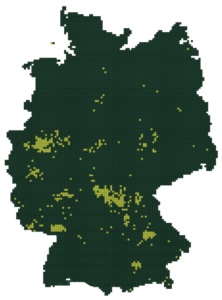Cotoneaster divaricatus
Spreading cotoneaster
Cotoneaster divaricatus is a small, deciduous shrub that can reach heights of 1.5 to 3 metres. The branches are widespread and form a dense structure. The leaves are elliptical to roundish, 1 to 3 cm long, with a smooth surface and a glossy green colour that changes to a bright red or orange colour in autumn. The flowers are small, about 5 mm in diameter, white and appear in clusters of 3 to 6 in late spring. The fruits are bright red berries about 6 mm in diameter that ripen in autumn and often remain on the shrubs into winter. Cotoneaster divaricatus prefers sunny to semi-shady sites and is well established in a wide range of soil types, including poor, dry soils. Its ability to reproduce vegetatively and its attractive appearance have contributed to its widespread use as an ornamental plant, but this has also encouraged its invasive nature.
Types of damage
Region of origin
China

Introduction vectors
Current distribution
Based on the FlorKart Database of the Federal Agency for Nature Conservation, as of 2013
Miscellaneous
Dispersion forecast
Indicates the proportion of land suitable for habitat under current and future climate conditions (2060-2080) under three emission scenarios (RCP26, RCP45 & RCP85).

powered by Advanced iFrame. Get the Pro version on CodeCanyon.
Habitat suitability under current climate conditions
These habitat suitability maps show for Cotoneaster divaricatus where suitable habitat conditions exist.
The map on the left shows this for current climate conditions. Below this are maps for the time classes 2040-2060 and 2061-2080, in which three different emission scenarios can be selected.
The slider at the top left allows you to adjust the opacity of the map to make orientation easier.
By clicking on the respective quadrant, information on the environmental conditions present in it can be called up.
The methodology is explained here beschrieben.
powered by Advanced iFrame. Get the Pro version on CodeCanyon.
powered by Advanced iFrame. Get the Pro version on CodeCanyon.













